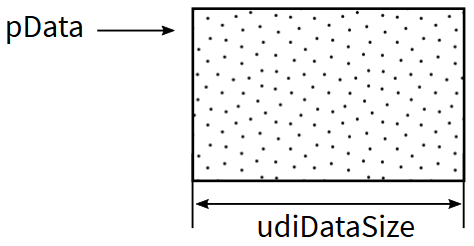SharedArea¶
Think about data structures like a STRING, ARRAY or STRUCT
We can model this kind of data structures in a general way as a block of data with an start
address pData and a size udiDataSize:

In CODESYS this kind of structures may be declared as following:
sString : STRING(255) := 'The quick brown fox jumps over the lazy dog';
wsString : WSTRING(255) := "✞♄℮ ⓠʊї¢к ♭ґøωη ḟ◎✖ ʝυღ℘﹩ øṽℯґ ⊥ℌ℮ ʟ@ℨƴ ḓøℊ";
aiArray : ARRAY[0..9] OF INT := [2,3,5,7,11,13,17,19,23,29];
TYPE STRUCTURE :
STRUCT
sString : STRING(255);
wsString : WSTRING(255);
aiArray : ARRAY[0..9] OF INT;
END_STRUCT
END_TYPE
myStructure : STRUCTURE := (sString:=sString, wsString:=wsString, aiArray:=aiArray);
In a single-core environment a simple function call to SysMemCpy will be enough to assign the content of this
variables to a other variable.
SysMemCpy(pDest:=ADR(sOtherString), pSrc:=ADR(sString), udiCount:=DINT_TO___XWORD(MIN(LEN(sString), SIZEOF(STRING(255)))));
This approach will not result in a consistent content of the other variable if we execute this statement in a multi-core environment and there are multiple writers and/or multiple readers at the same point in time on the same memory area.
In a typical application we will have some writers for each area and multiples readers.

The basic idea for an proper implementation approach is based on the possibility to assign the data types
POINTER or INTERFACE consistently in a multi-core environment with a simple assignment statement.
pElement := ADR(element);
itfString := StringBuilder('The quick brown fox');
The problem which is left is: How can we implement a adequate SysMemCpy in a multi-core environment.
The function block SharedArea and its methods will solve this problem.
- Function Blocks
- Interfaces